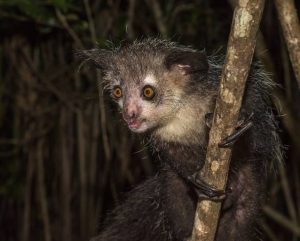Scientific name: Daubentonia madagascariensis
Conservation status:
Life expectancy: 10-15 years
Gestation period: 164 days
x
Lifestyle and Location:
- This lemur, along with every other lemur is endemic to Madagascar. They generally live around the coast, especially down the east coast and partway down the west coast. Their habitat is usually either rainforest or deciduous forest but, due to deforestation lots have now been seen to live on more cultivated land.
- They are active during the night and spend most of their life in trees, making it arboreal.
- In day time they sleep in spherical nests made from leaves, sticks and vines.
- They are solitary animals, only deliberately meeting up to mate, however, some males have been recorded to share parts of their territory and also have been seen sharing the same nest (but not using it at the same time). They only truly turn against each other when a woman needs a mate.
- Their diet consists of seeds, fruits, nectar, fungi and insect larvae, making them omnivorous.
Appearance:
In their younger days the aye-aye have thin silvery fur on their front with a stripe down their back. When they age, their fur turns thick and usually not one solid colour, with light fur on their face and front of neck but with greyish-brown on the rest of their body. When fully grown the aye-aye is usually around 30-40cm with a tail as long as their body. They typically weigh 2.5-2.7 kg
Joss‘s Facts
- The aye-aye is the largest nocturnal primate.
- To find their prey they gnaw holes in the bark of a tree using its specialised forward slanting teeth, with this small hole they can then put their long hook-like middle finger (that they have on each hand) to pull out the grubs.
- They can control the blood circulation to their long middle finger to control the sensitivity (normally barely any blood goes into it, however, when they need to feel the prey in the small holes they put more blood into their finger so they can feel around much better).
- Up to 80% of their night is taken up by foraging for food!
- The long middle finger, that is used to get larvae from trees has a ball and socket joint.
